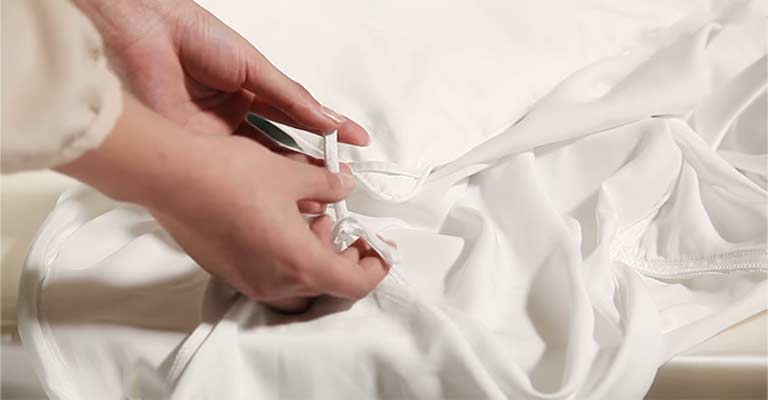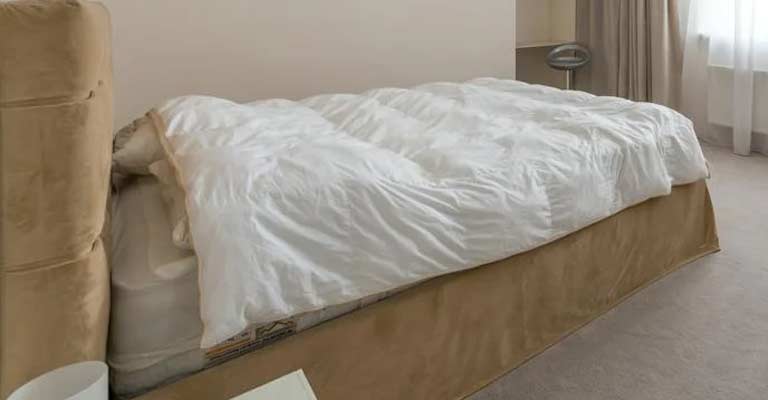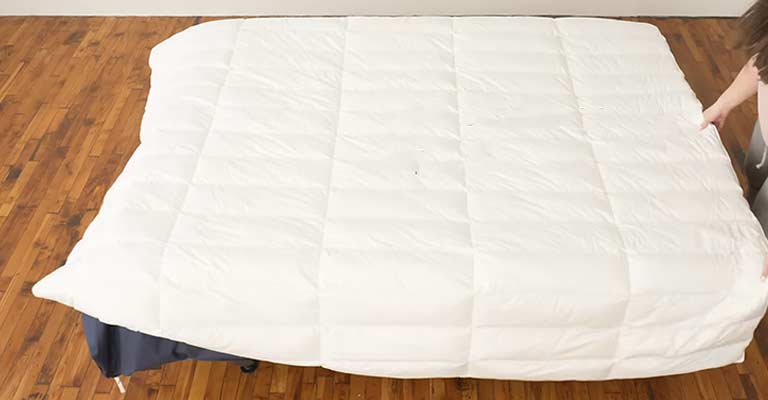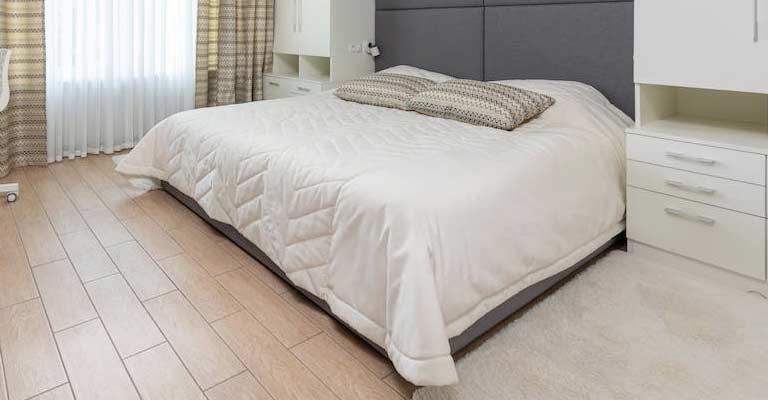Duvet covers offer versatile utility, serving not only as protective layers but also as standalone lightweight bedspreads or covers.
In the warmer summer months, when a heavy comforter becomes too much for a good night’s sleep, a duvet cover comes to the rescue.
It allows you to neatly store your comforter away, ensuring a cooler and more comfortable sleep environment. When the temperature drops again, simply bring out the comforter to stay snug and warm.
Turn Your Duvet Cover into a Light Summer Blanket
In our cozy, temperature-controlled homes, we usually use the same bedding all year round—except maybe for those warm flannel sheets.
But did you know, back in the day before we had central heating and air conditioning, people switched up their bedding with the seasons? They’d bring out heavier quilts in the fall and switch to lighter bedspreads in the spring.
The Benefits
Now, if you’ve got a duvet and its cover (or even two), you’re all set to do your own seasonal switch.
Using a duvet (with its cover) instead of a regular comforter, which usually doesn’t have a cover, comes with a super handy benefit – you can easily take off and wash the cover by itself.
And guess what? The same goes for using just the duvet cover (without the inside part) as a summer blanket.
Toss it in the washer with the rest of your bedding, and you’re good to go – everything stays nice and fresh.
Plus, it’s easy to match your style. When you first picked out your duvet cover, you probably thought about how it fits with the rest of your room.
So, if you want everything to look nice and put together, you can do it without having to find a whole new, lighter blanket or quilt to match your space.
Can You Use A Duvet Cover Without The Insert?

Absolutely! Surprised? Well, a duvet cover can do more than you might think. Imagine this scenario: your duvet is out of commission, but the cover is still in excellent shape. Get creative and use it for one of these purposes:
Decoration Delight
Duvet covers come in loads of colors, styles, and fabrics, catering to everyone’s tastes. Spruce up your beloved bedroom or even your living room with a fresh, lovely look.
Want that luxe hotel vibe? Opt for crisp flat sheets. Or maybe you’re into a more textured, heavy fabric to showcase your style – no problem!
You can even use different ones for each room, turning your home into a mini museum that wows every visitor!
For those who prefer simplicity, just throw it on your loveseat or sofa to add a little spice to the decor.
Or let it double as a weighted blanket for cozy family movie nights. It’s also perfect for kids’ bedrooms, where the design needs to keep up with their ever-changing interests.
Now, some might ask, “Why not use decorative blankets for these purposes?” Well, that’s a good option, but it can be too pricey for those on a tight budget.
Duvet covers, on the other hand, cost much less. Plus, washing and folding these thin fabric pieces is way easier than dealing with bulky comforters or quilted blankets!
As Flat Sheets and Top Sheets/Blankets
Do you struggle to stay cool at night, constantly bothered by excessive heat? If so, try using your thin silk duvet cover as flat sheets for coverage.
Say goodbye to thick, hot duvets and comforter sets – no more waking up feeling suffocated!
This trick is also great because it gives your comforters or duvets a break, extending their lifespan. You can always go back to them when winter or cooler months roll around.
Sure, some might argue that pulling the duvet off its cover can be a bit of a hassle. While some duvets can be tricky, it’s still way easier than wrestling with mattress sheets.
Plus, thanks to the cover’s thin top layer, making your bed the next morning is a breeze – much more time-efficient than dealing with flat sheets and a comforter cover!
Top Five Reasons to Use a Duvet Cover

To start, think of a duvet cover as a massive pillowcase for your down comforter. While it’s designed for down comforters, you can use any type inside.
The term “duvet” is French for comforter, so essentially, a duvet cover is a comforter cover. These covers typically feature a button or zipper enclosure at the bottom or top to secure the comforter in place.
Certain manufacturers get creative, using wooden logo-etched buttons on the bottom of Hawaiian duvets with a custom wrap-around design to keep the comforter snug.
However, some may place the buttons or zipper at the top of the bed, which, frankly, seems odd – who wants to sleep with buttons in their face all night?
For an extra secure fit, you can use padded comforter clips to bind the comforter corners to the duvet cover, preventing any unwanted sliding around.
Now, you might be thinking this sounds like a bit of effort compared to an already quilted comforter. So, let’s delve into the Top Five Reasons to Use a Duvet Cover:
1. Easy To Store And Switch
Fold up your duvet cover and tuck it away in the laundry pantry – it won’t hog much space. Unlike a bulky comforter that could dominate your entire closet, a duvet cover is a breeze to store.
Plus, swapping out a duvet cover is quick, giving your beach bedroom a fresh new look without much hassle.
2. Protects Your Down Comforter
Down comforters are becoming pricier, and you’d want to shield your investment from stains, tears, and feather loss. Under normal use, a duvet cover acts as a shield, keeping your down comforter nearly as good as new.
So, go ahead, invest in that luxurious goose down comforter, and let the duvet cover maintain your most valuable bedroom asset in tip-top shape.
Easy to Keep Clean
Most duvet covers are a breeze to clean – just toss them in the machine with your regular laundry. On the flip side, washing a comforter in a machine is usually a no-go (too bulky), and they often require pricey dry cleaning.
Not to mention the waiting game – a few days until you get your bedding back from the cleaners.
Quick Change in Style
Transforming the entire vibe of your beach bedroom is a piece of cake with a new duvet cover.
Typically priced a bit lower than a comparable comforter since duvet covers lack batting or fill, this option allows you to bring a fresh color scheme to redecorate your bedroom without breaking the bank.
You can even switch things up with different colored duvet covers according to the seasons. Picture a vibrant, fun Hawaiian fabric for spring and summer – perfect, right?
Doubles as a Bedspread
Duvet covers aren’t just for protecting your comforter; they can shine on their own as lightweight bedspreads or bed covers.
A hefty comforter can be a bit much for summer snoozing. With a duvet cover, you can stow away your comforter during the warmer months and easily bring it back out when the chill returns.
Whether you’re in Hawaii, Florida, the Caribbean, or any year-round warm tropical setting, a duvet cover is the ideal choice for maintaining a stylish beach bedroom and conquering the tropical heat.
Are There Any Drawbacks to Using Duvet Covers Alone?

While using duvet covers as standalone items has its advantages, it’s not all sunshine and rainbows. Let’s explore a couple of downsides:
1. Lack of Comfort
Duvet covers are designed to shield your duvet from dirt, dust, and stains. However, they aren’t exactly known for providing comfort on their own.
When it comes to pure comfort, blankets and duvets take the lead. So, if ultimate comfort is your priority, using duvet covers alone might not be the best choice. They’re better suited for those who prioritize a cooler sleep experience.
2. Compatibility Issues
Standard duvet covers aren’t one-size-fits-all. They might not snugly fit all mattress and bed sizes, leading to frequent slipping off.
For some, readjusting the cover every morning might not be a bother, but others might find it tedious and annoying.
How To Clean Your Duvet Cover For Better Standalone Usage
Regardless of how you choose to use your duvet covers, making the most of them involves proper maintenance. Here’s a simple guide to cleaning them:
Step 1:
Remove the cover from your duvet and assess its condition. If it’s stained, pre-treat those spots before tossing the duvet cover into the washing machine or dryer. (Most duvet covers are machine washable, so no need to worry!)
Step 2:
Opt for gentle, mild detergents, and avoid powdered detergents or fabric softeners. It’s also a good idea to wash the duvet cover separately or with other thin sheet sets or fabrics, avoiding a mix with thicker clothes.
Step 3:
Avoid hot water. While some may believe hot water is the best germ-fighting solution, warm water is just as effective without risking damage to the corner ties.
Step 4:
Tumble dry. Once the washing cycle is complete, promptly remove the linen duvet cover from the dryer for a well-maintained and ready-to-use item.
Step 5:
Now that your duvet cover is clean and refreshed, the choice is yours! You can use it as a standalone piece for a lighter touch or easily return it to your duvet insert for added warmth and coziness.
Whether you prefer the simplicity of just the cover or the snug embrace of the entire duvet set, your refreshed bedding is ready to enhance your sleep experience.
FAQs
Can A Duvet Cover Be Used As A Bedspread?
Absolutely! It’s a popular choice, and you can replace various bedding items like mattress protectors, fitted sheets, top sheets, bedspreads, bed toppers, and more with these cozy duvet covers.
Can You Use Duvet Covers Without an Insert Inside the Cover?
Certainly! Using duvet covers without any insert is totally possible. For more guidance, you can refer to bedding manufacturer manuals or the helpful tips provided above.
What Is The Point Of A Duvet Cover?
The primary purpose of a duvet cover is to safeguard your duvet, preventing it from damage and stains.
However, as emphasized throughout this article, duvet covers are versatile, and you can get creative, repurposing them in various situations to suit your needs.
How Often Should You Wash It?
A good rule of thumb is to wash duvet covers at least once a week. However, if you’re using them as flat or top sheets, you can reduce cleaning frequency to once a month or every two to three weeks.
Investing in high-quality duvet covers can also be a time-saver. Some models crafted from premium synthetic materials or natural fabrics can prevent up to 99% of bacterial growth.
This allows you to use them throughout the month without worrying about potential health issues.








